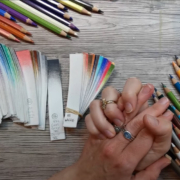4 Tips for Strong Composition in Drawing and Painting
One of the most important elements in making your drawings and paintings impressive and professional-looking is creating a good composition, right at the core of your subject. However, this is also an aspect of art that can be easily overlooked in the pursuit of, for example, “making it look right” and your choice of materials.
Composition refers to how you distribute the different elements and shapes on the surface in your drawings or paintings. In my own art, this is something I have been focused on since I started drawing and painting more seriously in the early 90s.
In my work with composition, I have distilled four main areas that are strong to consider, both individually and in combination, in the effort to create beautiful and captivating compositions. Common to these areas is that each constitutes two “poles,” two opposites, which it is important to experiment with and find your own way within. Below, I will go through each of these four areas of work with composition.

Light and Dark
The first and most important set is the relationship in your pictures between light and dark, on a grand scale, so to speak. How much space do the light and dark elements respectively take up in your picture? The more the dark elements dominate, the darker the overall character of your picture, and the more the light elements dominate, the lighter the overall character of your picture. It sounds obvious, but it is something that is easily overlooked.
Variation and Repetition
In your pictures, it is also very important to be conscious of which shapes you use and whether there is a rhythmic repetition of them to some extent. Repeating shapes in your pictures can create harmony and energy in your compositions. Already at this stage, the work of weaving your considerations about light and dark into a comprehensive manner begins.
Simplicity and Complexity
Do you have many elements in your picture? Or few? The amount of different elements in your picture has a crucial effect on its appearance. Often, you will find that pictures with many elements are more complex to look at, while pictures with few elements have a calmness and simplicity to look at.
Symmetry and Asymmetry
There is a big difference between whether your pictures “mirror” along the horizontal or vertical axis and create symmetry or whether they are more asymmetrical and uneven, for example, on the right and left sides of the picture. The work with this particular element shows a huge difference in pictures from different parts of the world throughout art history. Symmetrical pictures can, for example, be a portrait seen from the front, with the person placed in the middle of the picture, and a classic example of a more asymmetrical but still figurative composition can be a varied landscape, where there are very different elements in the picture from the right to the left side of the surface.
Synergy
All these elements of composition play out before our eyes all the time in real life, and you can train your attention to them and bring this into your pictures. Try to open your senses to the wonderful world of composition the next time you create a drawing or painting, and in real life.
Learn to work with composition in your drawings and paintings
At my online Art Soul Living – Creative Academy, I have an in-depth course in composition, Intuitive Composition, where you learn effective techniques to create beautiful compositions and how to translate this into concrete results in your drawings and paintings. In this course, you will learn all the best practices I have developed through long-term work with art, dating back to 1992.
In this course, I thoroughly go through the above categories and teach you how to strengthen your work with each one and blend them together into your own unique artistic expression.
Read more about the online Art Soul Living – Creative Academy here.
Best creative regards,
Ida Andersen Lang











Leave a Reply
Want to join the discussion?Feel free to contribute!